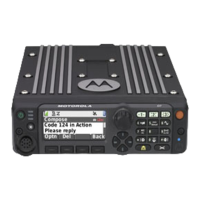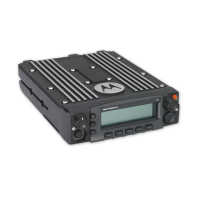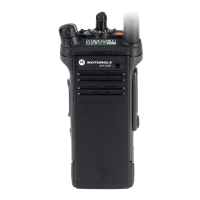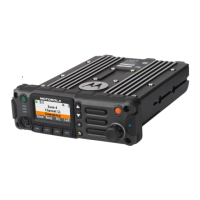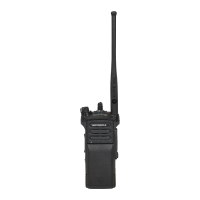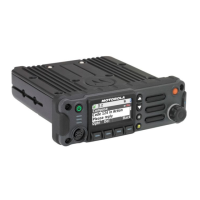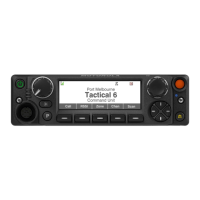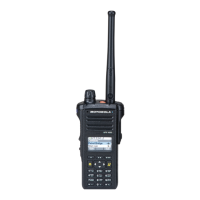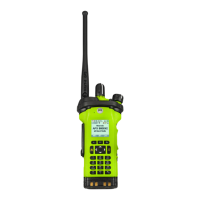Do you have a question about the Motorola APX 7000 and is the answer not in the manual?
| Digital Technology | P25 Phase 1 and Phase 2 |
|---|---|
| Emergency Button | Yes |
| Frequency Range | 136-174 MHz (VHF), 380-470 MHz (UHF Range 1), 450-520 MHz (UHF Range 2), 764-870 MHz (700/800 MHz) |
| Display | Color LCD |
| Encryption | AES, DES |
| Water Resistance | IP67 |
| GPS | Yes |
| Bluetooth | Yes |
| Operating Temperature | -30°C to +60°C |
| Weight | 391 g (with standard battery) |
Controls for turning the radio on and off.
How to select zones and channels.
FCC and Industry Canada compliance notices.
Explains basic operations and how to use the guide.
Defines warning, caution, and note notations.
Details latest features for radio performance.
Instructions for charging the radio battery.
Steps to attach the battery to the radio.
Steps for attaching the antenna to the radio.
Identifies various parts and controls of the radio.
Explains how radio controls can be programmed by a technician.
Describes various radio functions that can be assigned.
Lists assignable settings or utility functions.
Details the alphanumeric keypad and its functions.
Covers Bluetooth on/off, pairing, and device management.
Accesses and manages radio contacts.
Initiates or cancels emergency alarm or call.
Determines current location and bearing.
Clears Man Down mode alarm.
Saves current zone/channel to a button/softkey.
Explains various icons indicating radio status.
Indicates radio-to-radio or repeater connection.
Monitors selected channel for activity.
Manages voice muting during calls.
Sets radio power level to low or high.
Indicates radio is scanning a scan list.
Shows activity on Priority-One/Two channels.
Indicates radio is in view or program mode.
Indicates vote scan feature is enabled.
Provides access to zones within a bank.
Provides access to a larger number of zones.
Indicates secure or clear operation status.
Indicates AES secure operation status.
Indicates GPS feature and signal status.
Shows user association with the radio.
Indicates that data activity is present.
Indicates text entry is in hexadecimal mode.
Indicates text entry is in numeric mode.
Indicates the first character is capitalized.
Indicates text entry is in normal text mode.
Indicates text entry is in uppercase mode.
Indicates text entry is in lowercase mode.
Indicates lowercase text with predicted words.
Indicates mixed case text with predicted words.
Indicates uppercase text with predicted words.
Indicates Bluetooth is on and ready for connection.
Indicates Bluetooth is connected to an external device.
Indicates LTE system is available and connected.
Indicates the radio is receiving LTE signal.
Indicates the radio is transmitting LTE signal.
Indicates radio-to-radio or repeater connection.
Monitors selected channel for activity.
Manages voice muting during calls.
Sets radio power level to low or high.
Indicates radio is scanning a scan list.
Shows activity on Priority-One/Two channels.
Indicates radio is in view or program mode.
Indicates vote scan feature is enabled.
Provides access to zones within a bank.
Provides access to a larger number of zones.
Indicates secure or clear operation status.
Indicates AES secure operation status.
Indicates GPS feature and signal status.
Shows user association with the radio.
Indicates that data activity is present.
Indicates text entry is in hexadecimal mode.
Indicates text entry is in numeric mode.
Indicates the first character is capitalized.
Indicates text entry is in normal text mode.
Indicates text entry is in uppercase mode.
Indicates text entry is in lowercase mode.
Indicates lowercase text with predicted words.
Indicates mixed case text with predicted words.
Indicates uppercase text with predicted words.
Indicates Bluetooth is on and ready for connection.
Indicates Bluetooth is connected to an external device.
Indicates LTE system is available and connected.
Indicates the radio is receiving LTE signal.
Indicates the radio is transmitting LTE signal.
Indicates simultaneous LTE receiving and transmitting.
Indicates ARS user logged in successfully with LTE.
Indicates ARS user logged in successfully with LTE.
Indicates LTE transmitting signal with ARS user logged in.
Indicates simultaneous LTE signal with ARS user logged in.
Indicates ARS user login failed in LTE system.
Icons and options for efficient TMS operation.
Indicates the text message could not be sent.
Indicates a new or unread message.
Indicates the selected text message has been read.
Indicates composing message with normal priority.
Indicates the index of the current message being viewed.
Indicates message priority or request for reply.
Indicates request for reply feature is toggled on.
Indicates message priority and request for reply.
Lists and describes TMS menu options.
Icons indicating different call types on display.
Shows operational status of the radio via LED.
Changes display backlight and adds color bar for events.
Lists alert tones and when they occur.
Describes tones heard for timeouts, inhibits, and out of range.
Describes tones for busy system.
Describes tones for key presses and test passes.
Describes tones for central echo and volume set.
Describes tones for failsoft, call back, and keyfail.
Describes tones for low battery and site trunking.
Describes tones for GPS fails.
Describes tone for searching private call target.
Describes tones for enhanced call sent and phone call received.
Describes tone for new message.
Describes tone for priority status.
Describes tones for Bluetooth paired/connected.
Describes tones for Bluetooth unpaired/disconnected.
Describes tones for Man Down continuous alerts.
Describes tones for Enhanced Zone Bank up/down.
Displays and alerts for phone calls.
Methods for selecting a radio zone.
Methods for selecting a radio channel.
Quick search for a channel by alias.
Saves current zone/channel to a programmable button or softkey.
Saves frequently used zone and channel to softkeys.
Saves frequent zone and channel to programmable buttons.
Procedures for receiving and responding to radio calls.
How to receive and respond to a talkgroup call.
How to receive and respond to a private call.
How to receive and respond to telephone calls.
Methods for making a radio call.
Steps to make a call to a group of users.
Steps to make a private call.
Steps to make an enhanced private call.
Steps to make a telephone call.
Toggles between talkaround and repeater modes.
Explains the monitor feature for clear channels.
Methods for monitoring a channel.
Listens for activity on Private Line (PL) calls.
Receive or make calls to specific individuals.
Indication scenarios when receiving a selective call.
Steps to make a selective call.
Define groups for sharing conventional channels.
Steps to select and save a talkgroup.
Send data calls to dispatcher about predefined status.
Temporarily reassign radios to a channel for communication.
Notify dispatcher for new dynamic regrouping assignment.
Store frequent channels in Dynamic Zones.
Procedure to select a dynamic channel from a zone.
Save a channel from a list into the dynamic zone.
Save a channel by its name into the dynamic zone.
Delete a channel from the dynamic zone.
Provides address-book capabilities for calls.
Removes a contact from a call list.
Overview of contact editing methods.
Edits the alias (name) of a contact entry.
Edits the ID (number) of a contact entry.
Edits the call type associated with a contact.
Displays all numbers associated with a contact entry.
Information on creating and assigning scan lists.
Displays the members of a scan list.
Lets you change scan list members and priorities.
Changes the priority status of channels in a scan list.
Changes priority status of displayed channels.
Monitors traffic on channels by scanning a list.
Toggles the scan feature on or off.
Temporarily changes a channel to Priority-Two.
Temporarily removes unwanted channels from scan list.
Restores deleted nuisance channels.
Allows radio to work as a pager.
How to receive a call alert page.
Methods for sending a call alert page.
Indicates a critical situation.
Sends emergency alarm/call on current channel.
Reverts to emergency channel for alarm/call.
Reverts to emergency talkgroup for alarm/call.
Sends data transmission identifying radio sending emergency.
Gives radio priority access to a talkgroup.
Gives priority access to conventional channel or talkgroup.
Sends emergency alarm without audio or visual indicators.
Rules for changing channels during emergency.
Prevents radio from turning off during emergency.
Senses user trouble via tilt angle or lack of motion.
Sets time before user is warned of Man Down condition.
Sets time before Emergency alarm is transmitted.
Alerts related to Man Down feature activation.
Alerts related to Man Down Enhanced feature.
Process when Man Down condition leads to emergency.
Procedures to exit Man Down feature.
Steps to reinitiate Man Down feature.
Procedure to test the Man Down feature.
Automated data application registration for the radio.
Methods for selecting or changing ARS mode.
Associates user with radio for data applications.
Steps to log in as a user.
Procedures for logging out of the radio.
Allows sending and receiving messages.
Methods to access TMS features.
Steps to compose and send a new text message.
Steps to send predefined messages.
Append priority status and request reply to messages.
Marks a message as important.
Requests a reply to a message.
Removes priority status from a message.
Removes request reply status from a message.
Append priority status and reply request to a message.
Remove priority status and reply request from a message.
Overview of managing text messages.
Procedures for receiving text messages.
Accesses messages saved previously in the Drafts folder.
Information about messages saved in the Sent folder.
Displays text messages from the Inbox.
Steps to reply to a received text message.
Accesses messages saved previously in the Drafts folder.
Information about messages saved in the Sent folder.
Displays text messages from the Sent folder.
Deletes a text message from Inbox, Draft, or Sent.
Deletes all text messages in a selected folder.
Send/receive messages and run database queries.
Configures user name, ID, and password for messaging.
Authenticates with username, ID, password, and passcode.
Steps to log in using two-factor authentication.
Procedures for logging out of two-factor authentication.
Send queries after successful two-factor authentication.
Receives requested information in TMS format.
Provides high level of voice security on channels.
Turns on secure transmission mode.
Turns on clear transmission mode.
Procedures for managing encryption keys.
Steps to select and save an encryption key.
Selects one or more groups of encryption keys.
Erases all or selected encryption keys.
View or define MDC OTAR features.
Reduces channel noise during transmission.
Reduces background noise and enhances speech.
Expands speech while maintaining noise flow.
Reduces unwanted FM noise pulses.
Provides robust security for encryption keys.
Enables a robust security system to protect keys.
Steps to unlock the radio using a password.
Procedures to change the radio's password.
Procedures to change the tactical inhibit password.
Enables or disables the radio lock feature.
Allows stunning or killing another radio remotely.
Stuns another radio remotely via menu.
Steps to stun another radio.
Renders your radio or another radio inoperable.
Renders another radio inoperable via over-air command.
Makes your own radio inoperable.
Uses GPS satellites to determine geographical location.
Explains GPS technology and performance factors.
Guidelines to maximize GPS fix ability.
Determines current location using a location menu.
Displays location coordinates in MGRS format.
Steps to access the outdoor location feature.
Saves the current location as a waypoint.
Displays a list of saved waypoints.
Edits the alias (name) of a saved waypoint.
Edits coordinates of Home or Destination waypoints.
Deletes a single saved waypoint.
Deletes all saved waypoints.
Calculates distance and bearing to a saved waypoint.
Exits Location menu and returns to Home screen in emergency.
Shows peer location for radio-to-radio transmissions.
Defines a virtual perimeter based on GPS.
Procedure when entering a predefined Geofence area.
Manages trunking system operations.
Ensures continuous communication during system failure.
Site reverts to site trunking if zone controller loses communication.
Locks radio onto a specific site, preventing roaming.
View current site name or force radio to change site.
Displays current site name and signal strength.
Steps to change the current site.
Extends radio functionality via Motorola accessories.
Methods to turn the Bluetooth on.
Methods to turn the Bluetooth off.
Configures Bluetooth pairing type and duration.
Defines settings for Bluetooth connection retention.
Pairs radio with accessories using LF-MPP.
Scenarios and indications for lost Bluetooth connection.
Supports pairing authentication for correct device recognition.
Scans for and pairs with Bluetooth devices.
Enables other devices to search for your radio.
Handles pairing requests from other Bluetooth devices.
Turns off radio's visibility to other Bluetooth devices.
Verifies correct device using Authentic PIN.
Accepts or rejects pairing requests with PIN verification.
Pairs with generated numeric PIN for authentication.
Pairs using manually keyed-in PIN.
Routes audio from radio to headset via Bluetooth.
Routes audio from headset back to radio via Bluetooth.
Adjusts radio volume from connected Bluetooth device.
Views and clears Bluetooth device information.
Clears all Bluetooth device information from radio.
Edits the friendly name for Bluetooth devices.
Pairs the radio with a LEX 700 device.
Upgrades configuration data over-the-air.
Accepts, delays, or rejects configuration upgrades.
Audibly indicates current mode, zone, or channel.
Intelligent lighting and audio alerts for site notifications.
Sends Site Selectable Alert to a single site.
Sends SSA notification to single site using manual entry.
Sends Site Selectable Alert to all sites.
Sends SSA notification to all available sites.
Stops SSA notification for a single site.
Stops SSA notification for a single site via manual entry.
Stops SSA notification for all sites.
Stops SSA notification for all available sites.
Enhances radio operation via LTE broadband network.
Describes changing from LTE to non-LTE channels.
Describes changing from LTE to unprogrammed channels.
Describes entering or exiting out-of-range sites.
Provides access to radio utilities.
View recent incoming and outgoing call information.
Steps to turn on LTE via the LTE menu screen.
Steps to turn on LTE using the LTE button.
Steps to turn off the LTE connection.
Definitions of statuses shown on the LTE screen.
Describes changing from LTE to non-LTE channels.
Describes changing from LTE to unprogrammed channels.
Describes entering or exiting out-of-range sites.
Provides access to radio utilities.
View recent incoming and outgoing call information.
Flips the content of the top display upside down.
Allows access to zones via A-B-C switch.
Allows communication in more zones.
Consists of three zones, allowing navigation through zones.
Reduces transmit power level for specific cases.
Manually switches visual and audio settings.
Displays or hides the radio alias (name).
Selects speaker route for radio audio.
Enables/disables display backlight for visibility.
Locks keypad, buttons, knobs, and switches to prevent entry.
Enables/disables tones for navigation buttons, controls, keypad.
Enables or disables voice transmission.
Turns off transmitter after preset timer setting.
Allows setting the radio's time and date.
Steps to edit the radio's time and date.
Filters unwanted calls with low signal strength.
Overrides coded squelch (DPL/PL) on channels.
Displays radio ID of the transmitting radio.
Prevents users from talking over others on active channels.
Stops all transmissions (voice and data).
Steps to enable transmit inhibition.
Steps to disable transmit inhibition.
Displays current battery capacity and charge cycles.
Accesses battery details.
Provides information about radio's hardware and software.
Displays various radio information details.
Displays device name, IP address, and status.
Displays programmable functions assigned to controls.
Allows changing your username.
Guidelines for proper radio care and maintenance.
Instructions for cleaning the radio's external surfaces.
Guidance on handling the radio to prevent damage.
Information on repair and maintenance services.
Information on battery charge status and indicators.
Visual representation of battery charge levels.
Information on battery recycling programs.
Link to APX radio accessories and compatibility information.
Details on emergency and non-commercial channels.
Procedure for sending distress calls.
Information on using VHF Channel 9.
Shipboard radio compliance with FCC rules.
List of VHF marine channels and frequencies.
Technical specs for RS232, USB, and SB9600 interfaces.
Radio compliance for maritime distress and safety frequencies.
Acknowledgment of communication.
A channel that has traffic on it.
An RF signal with a continuous nature.
Automatic Registration Service.
Motorola standard for digital trunked communications.
Motorola standard for digital conventional communications.
Allows radio to automatically scan scan list members.
Open wireless technology standard for data exchange.
Process for forming a paired Bluetooth connection.
Privately pages an individual by sending an audible tone.
Responds to RF carrier presence by opening audio circuit.
Software-controlled device for trunked radios.
Group of characteristics like frequency pairs and parameters.
Channel for two-way data path in trunking systems.
Refers to radio-to-radio comms, sometimes via repeater.
Scan list including only conventional channels.
Commercial Off-The-Shelf.
Codeplug.
A visual tracking marker (blinking line) on display.
Radio locked after failed unlock attempts.
Coded squelch using data bursts.
An RF signal with a pulsed nature.
Individual managing radio system.
Digital Signal Processing.
Temporarily reassigns radios to a channel.
Dynamic System Resilience.
Encrypted Integrated Data.
Electrical Serial Number.
Allows comms during central controller failure.
Federal Communications Commission.
Frequency Modulation.
Disconnect.
First display info after radio self-test.
Integrate Circuit Card Identity.
International Mobile Equipment Identifier.
International Mobile Subscriber Identity.
Inter-OS User for user IP traffic.
Inter-OS Control for control IP traffic.
Adapter name used by the radio for LTE traffic.
Integrated Voice and Data.
Key-variable loader for loading encryption keys.
Liquid crystal display.
Light-emitting diode.
Lithium ion.
Long Term Evolution for wireless communication.
Senses user trouble via tilt or motion monitoring.
Mission Critical Wireless.
Motorola Data Communication.
Software-activated feature at bottom of display.
Checks channel activity by pressing Monitor button.
Scan list including talkgroups and channels.
Operates on digital channels to reduce interference.
Nickel-metal-hydride.
User talks on preprogrammed emergency channel.
Operation Critical Wireless.
Over-the-air rekeying.
One-way alert with audio/display messages.
Set of unique features specific to a radio.
Personal Identification Number.
Software application for real-time operations and system administration.
Software feature activated by qualified technician.
Private conversation with another radio user.
Sub-audible tone for receiver decoding.
Radio control with assigned feature.
Push-To-Talk button for transmitter engagement.
Part of frequency spectrum for audio and infrared light.
Feature for improving comms range via transmit/receive facility.
Call select individual for privacy.
Digital P25 traffic with correct NAC and talkgroup.
Circuitry reducing unwanted signals.
Synchronous Serial Interface.
Speaker muted, but receives data.
Pre-defined messages for conditional communication.
User talks on channel selected before emergency state.
Bypass repeater for direct unit-to-unit comms.
Organization of radio users communicating together.
Text Messaging Service.
Automatic sharing of comms paths among users.
Scan list including talkgroups from the same trunking system.
Unique Shadow Key.
Coordinated Universal Time.
Adapter name used by the radio for encrypted LTE traffic.
A grouping of channels.
Warranty details for Motorola communication products.
Defines warranty coverage periods for products and accessories.
Sets forth Motorola's responsibilities and remedies.
Explains state-specific legal rights regarding warranty.
Instructions for obtaining warranty service.
Lists items and conditions not covered by the warranty.
Provisions regarding Motorola's patent and software rights.
Specifies the governing law for the warranty.
